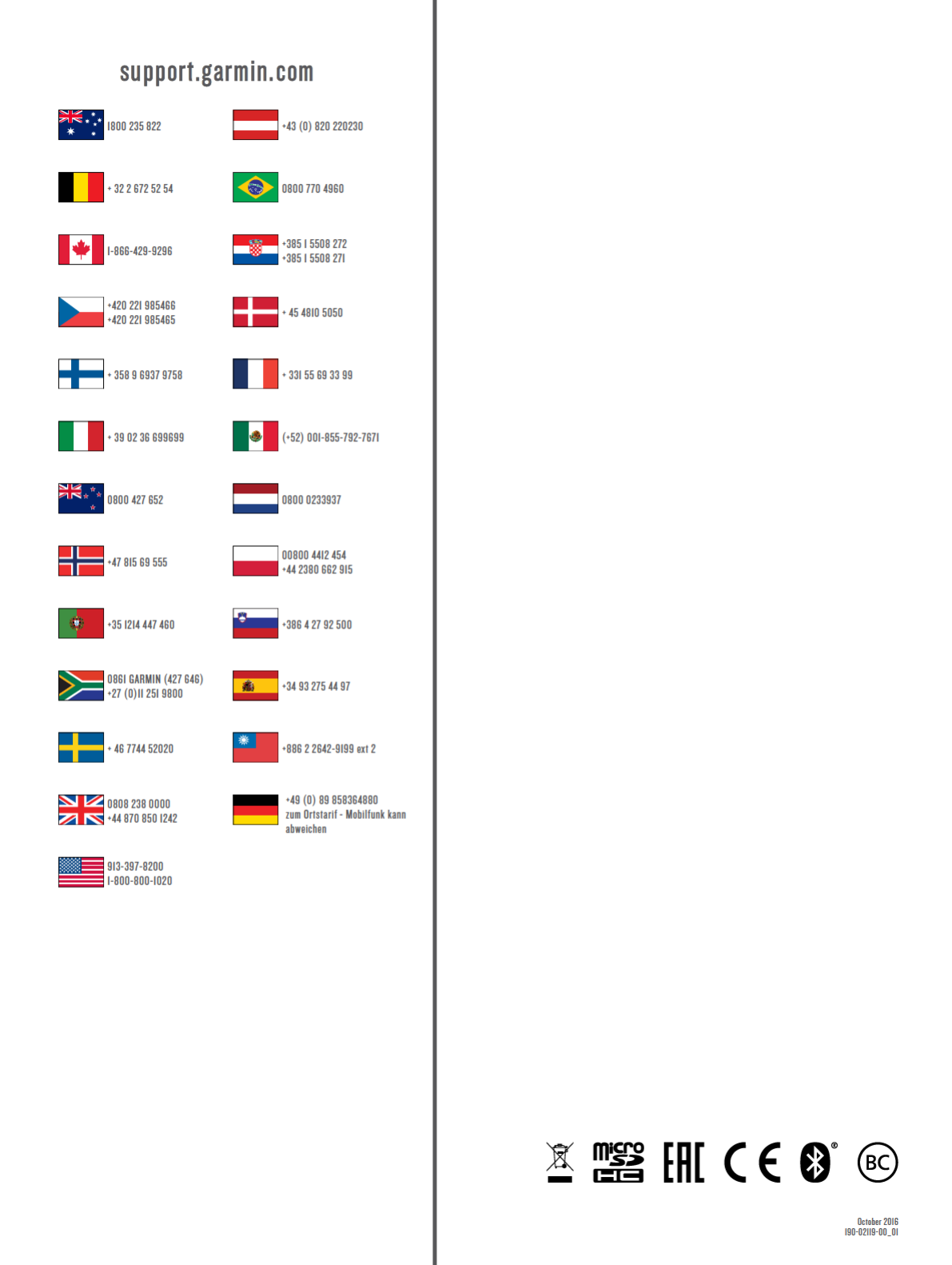Garmin 03101 Digital Transmissions System 2412-2462 MHz User Manual
Garmin International Inc Digital Transmissions System 2412-2462 MHz
Garmin >
Contents
- 1. User Manual Part 1
- 2. User Manual
- 3. User Manual 1
User Manual
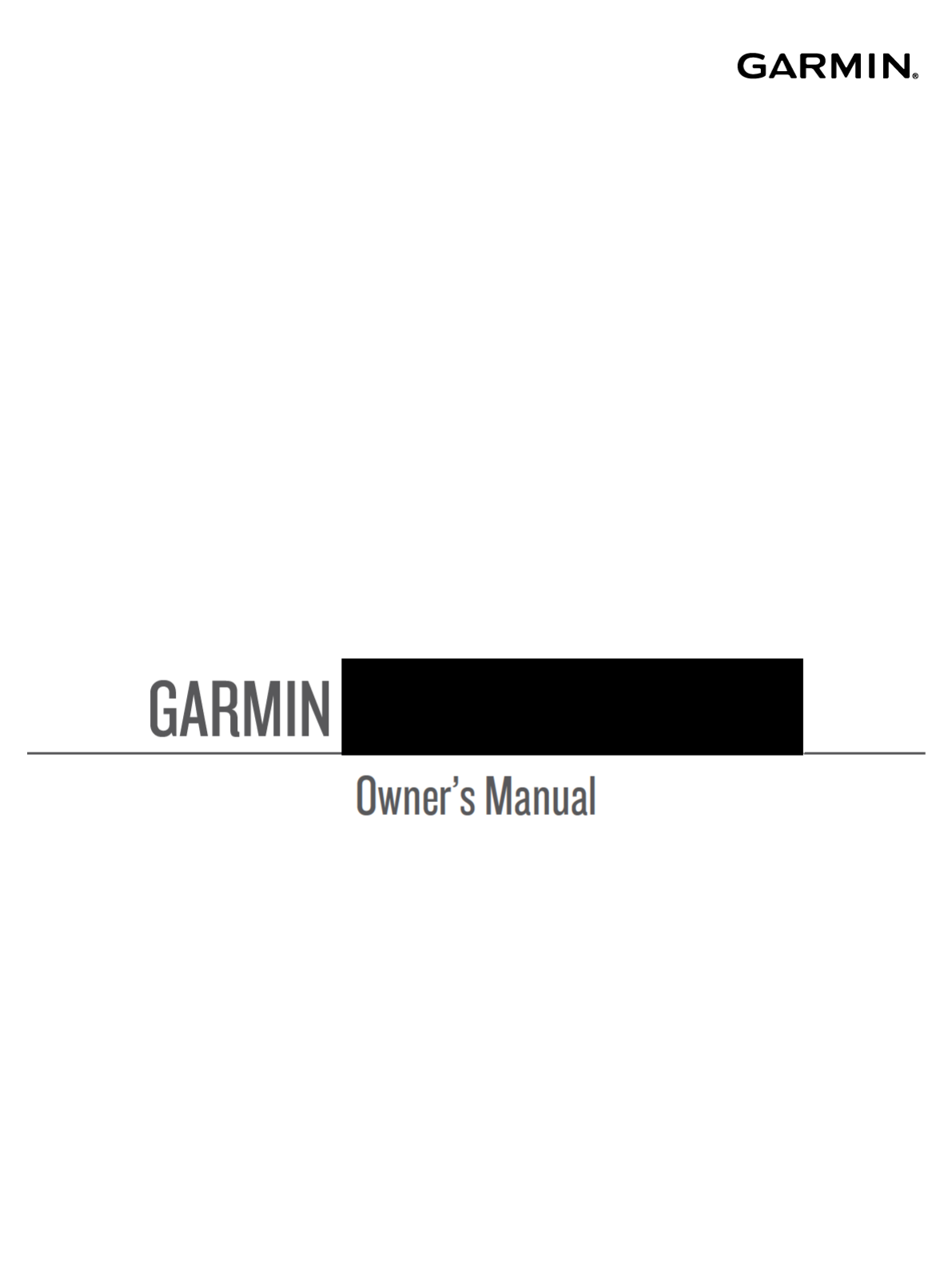

© 2016 Garmin Ltd. or its subsidiaries
All rights reserved. Under the copyright laws, this manual may not be copied, in whole or in part, without the written consent of Garmin. Garmin reserves the right to change or improve its products and to make changes in the content of this
manual without obligation to notify any person or organization of such changes or improvements. Go to www.garmin.com for current updates and supplemental information concerning the use of this product.
Garmin® and the Garmin logo are trademarks of Garmin Ltd. or its subsidiaries, registered in the USA and other countries. These trademarks may not be used without the express permission of Garmin.
Garmin ™, Garmin Express™, myTrends™, nüMaps Guarantee™, and nüMaps Lifetime™ are trademarks of Garmin Ltd. or its subsidiaries. These trademarks may not be used without the express permission of Garmin.
Android™ is a trademark of Google Inc. Apple® and Mac® are trademarks of Apple Inc, registered in the U.S. and other countries. The Bluetooth® word mark and logos are owned by the Bluetooth SIG, Inc., and any use of such word mark or logo by
Garmin is under license. Foursquare® is a trademark of Foursquare Labs, Inc. in the U.S. and in other countries. HD Radio™ and the HD logo are trademarks of iBiquity Digital Corporation. HD Radio Technology manufactured under license from
iBiquity Digital Corporation. U.S. and foreign patents. microSD® and the microSDHC logo are trademarks of SD-3C, LLC. TripAdvisor® is a registered trademark of TripAdvisor LLC. Windows®, Windows Vista®, and Windows XP® are registered
trademarks of Microsoft Corporation in the United States and other countries.
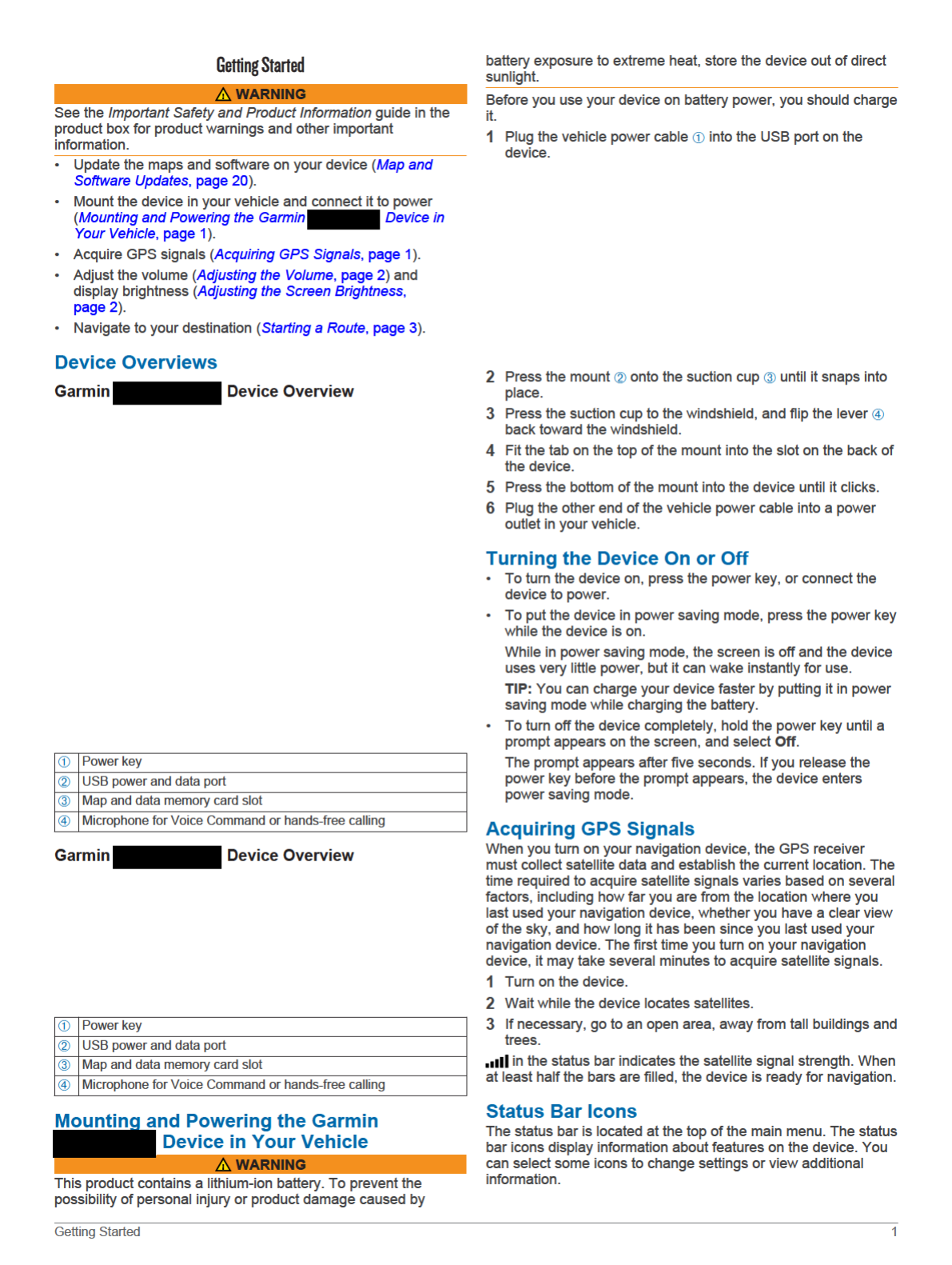
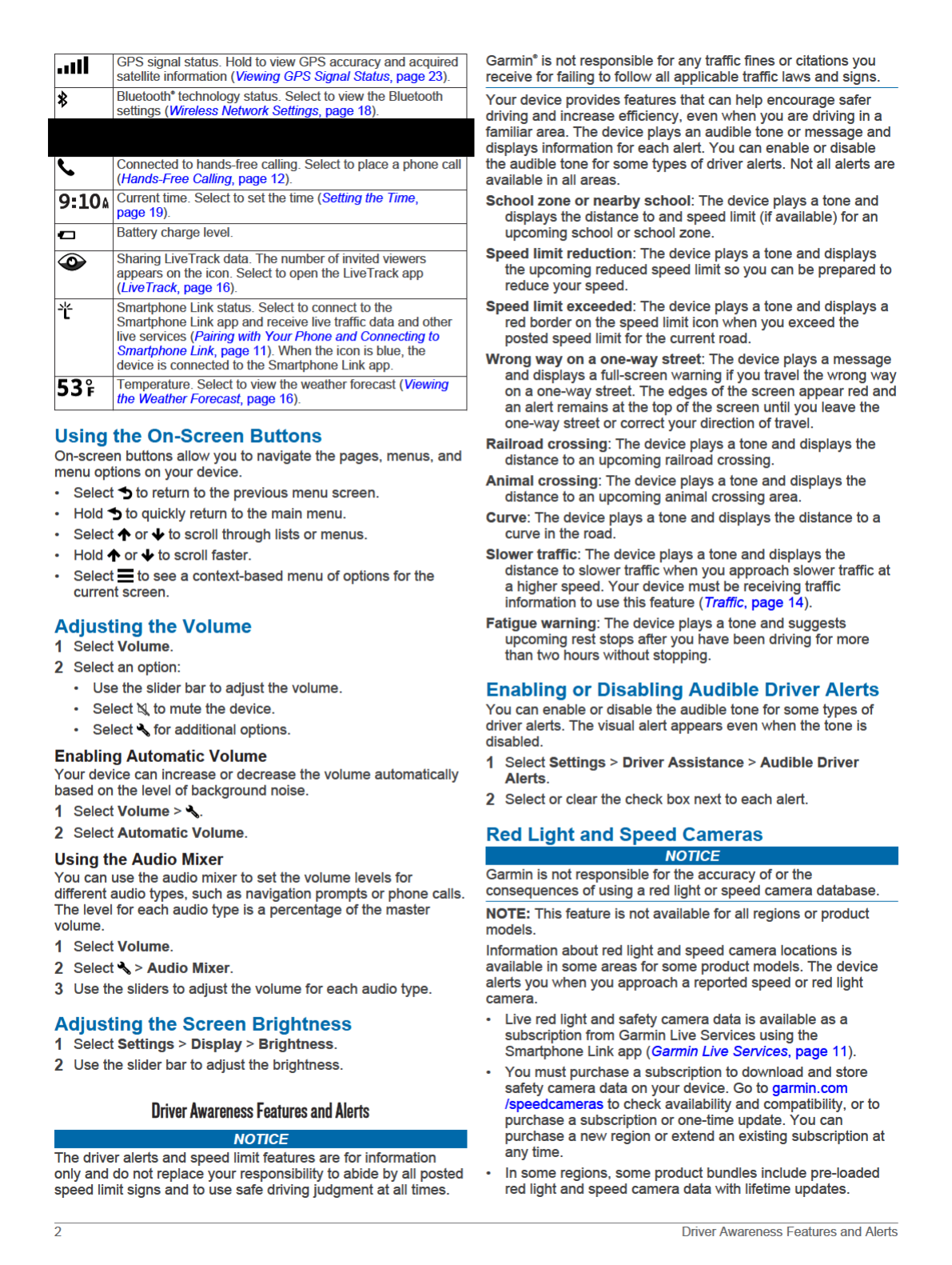
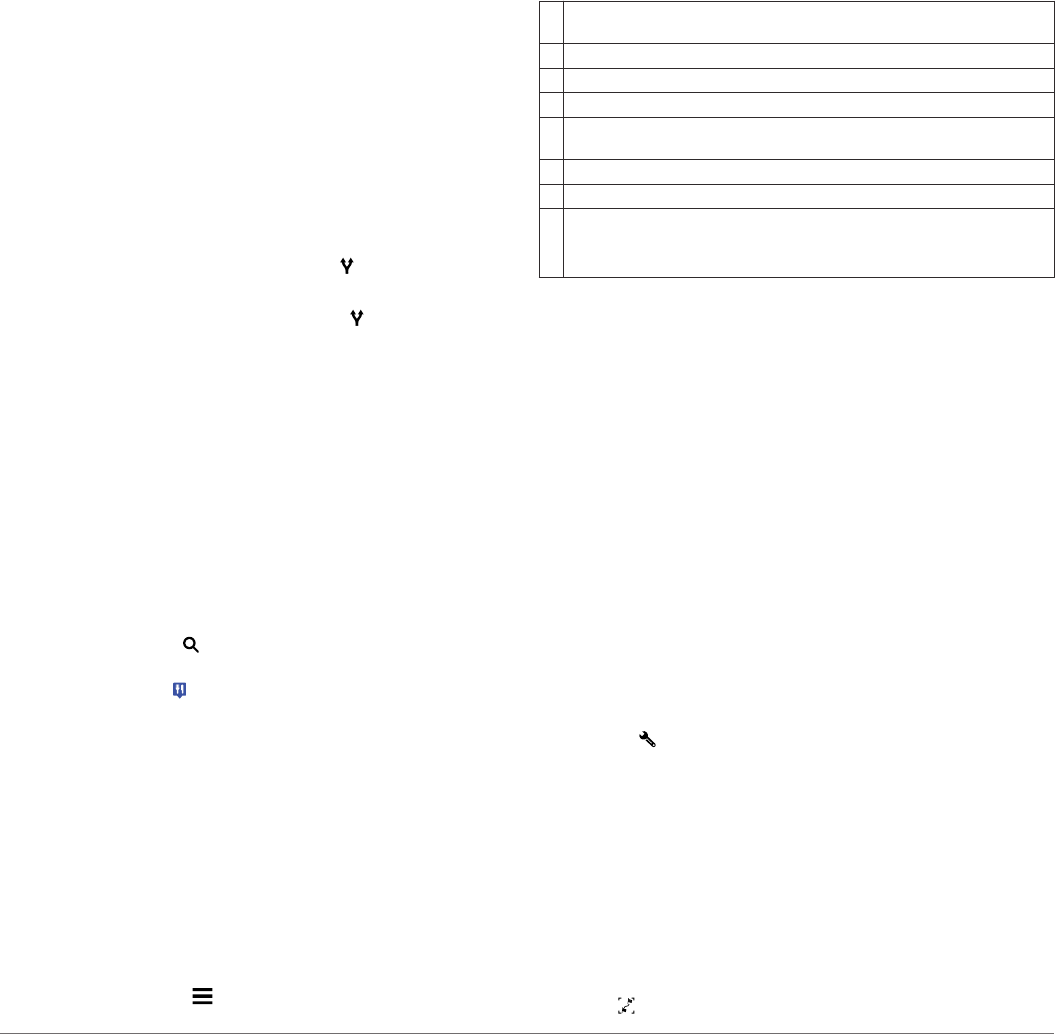
• You can use the Garmin Express™ software (garmin.com
/express) to update the camera database stored on your
device. You should update your device frequently to receive
the most up-to-date camera information.
Navigating to Your Destination
Routes
A route is a path from your current location to one or more
destinations.
• The device calculates a recommended route to your
destination based on the preferences you set, including the
route calculation mode (Changing the Route Calculation
Mode, page 5) and avoidances (Avoiding Delays, Tolls,
and Areas, page 5).
• You can start navigating to your destination quickly using the
recommended route, or you can select an alternate route
(Starting a Route, page 3).
• If there are specific roads you need to use or avoid, you can
customize the route (Shaping Your Route, page 5).
• You can add multiple destinations to a route (Adding a
Location to Your Route, page 4).
Starting a Route
1Select Where To?, and search for a location (Finding and
Saving Locations, page 6).
2Select a location.
3Select an option:
• To start navigating using the recommended route, select
Go!.
• To choose an alternate route, select , and select a route.
Alternate routes appear to the right of the map.
• To edit the course of the route, select > Edit Route, and
add shaping points to the route (Shaping Your Route,
page 5).
The device calculates a route to the location and guides you
using voice prompts and information on the map (Your Route on
the Map, page 3). A preview of the major roads in your route
appears at the edge of the map for several seconds.
If you need to stop at additional destinations, you can add the
locations to your route (Adding a Location to Your Route,
page 4).
Starting a Route by Using the Map
You can start route by selecting a location from the map.
1Select View Map.
2Drag and zoom the map to display the area to search.
3If necessary, select to filter the displayed points of interest
by category.
Location markers ( or a blue dot) appear on the map.
4Select an option:
• Select a location marker.
• Select a point, such as a street, intersection, or address
location.
5Select Go!.
Going Home
The first time you start a route home, the device prompts you to
enter your home location.
1Select Where To? > Go Home.
2If necessary, enter your home location.
Editing Your Home Location
1Select Where To? > > Set Home Location.
2Enter your home location.
Your Route on the Map
As you travel, the device guides you to your destination using
voice prompts and information on the map. Instructions for your
next turn or exit, or other actions appear across the top of the
map.
ÀNext action in the route. Indicates the next turn, exit, or other action
and the lane in which you should travel, if available.
ÁDistance to the next action.
ÂName of the street or exit associated with the next action.
ÃRoute highlighted on the map.
ÄNext action in the route. Arrows on the map indicate the location of
upcoming actions.
ÅVehicle speed.
ÆName of the road on which you are traveling.
ÇEstimated arrival time.
TIP: You can touch this field to change the information it shows
(Changing the Map Data Field, page 10).
Active Lane Guidance
As you approach some turns, exits, or interchanges in your
route, a detailed simulation of the road appears beside the map,
if available. A colored line À indicates the proper lane for the
turn.
Viewing Turns and Directions
While navigating a route, you can view upcoming turns, lane
changes, or other directions for your route.
1From the map, select an option:
• To view upcoming turns and directions as you navigate,
select > Turns.
The map tool displays the next four turns or directions
beside the map. The list updates automatically as you
navigate the route.
• To view the complete list of turns and directions for the
entire route, select the text bar at the top of the map.
2Select a turn or direction (optional).
Detailed information appears. An image of the junction may
appear for junctions on major roadways, if available.
Viewing the Entire Route on the Map
1While navigating a route, select anywhere on the map.
2Select .
Navigating to Your Destination 3
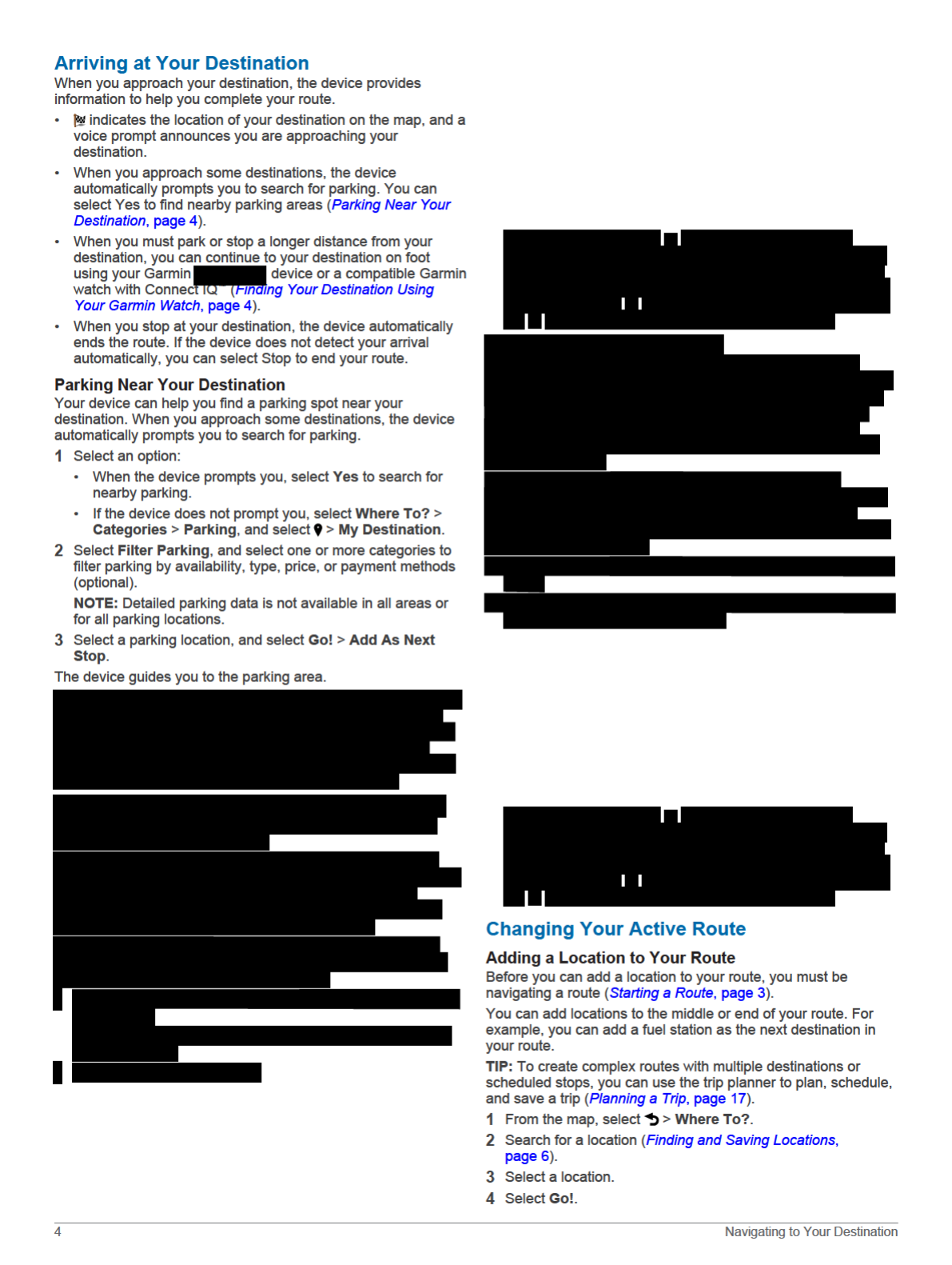
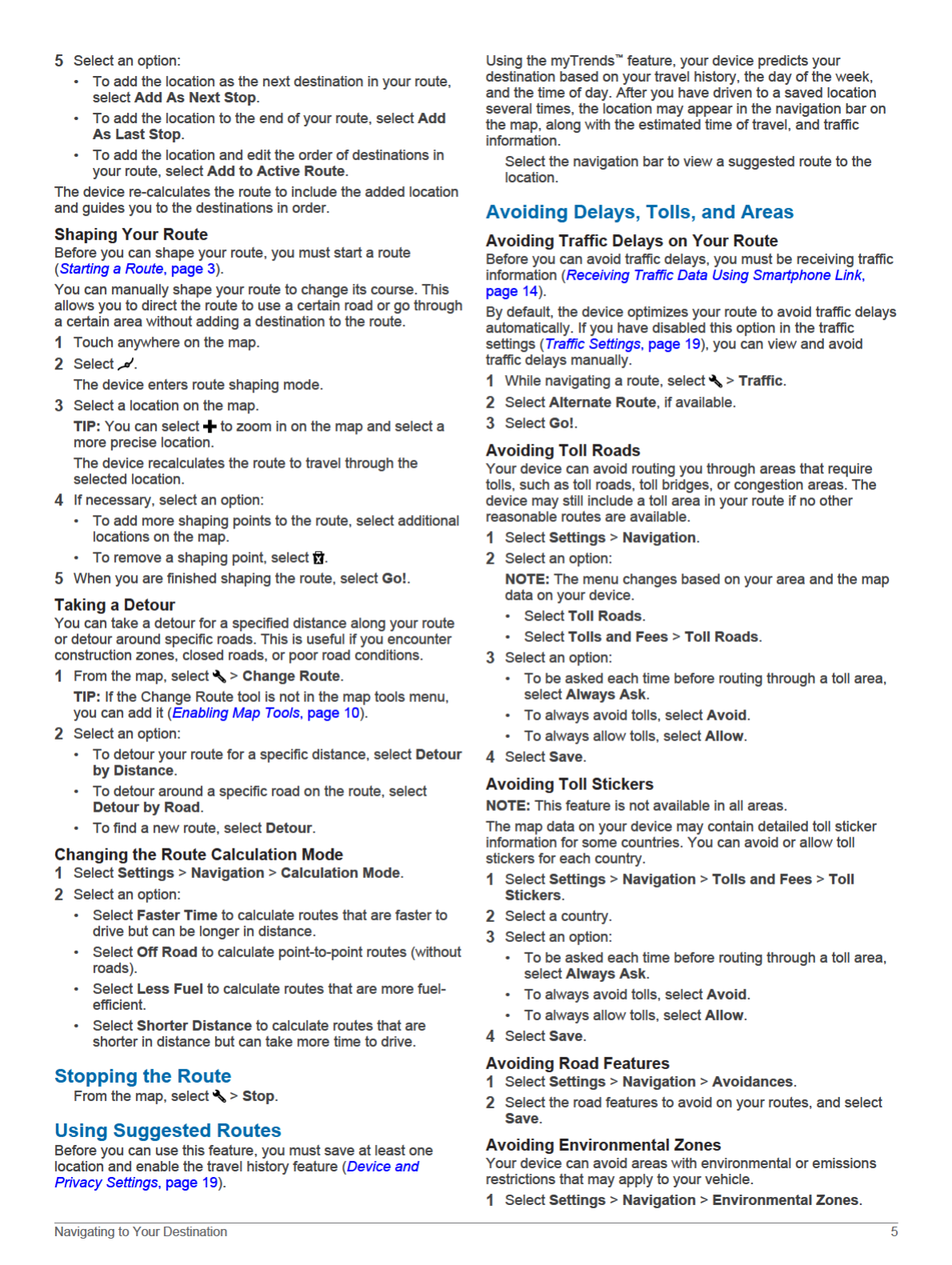
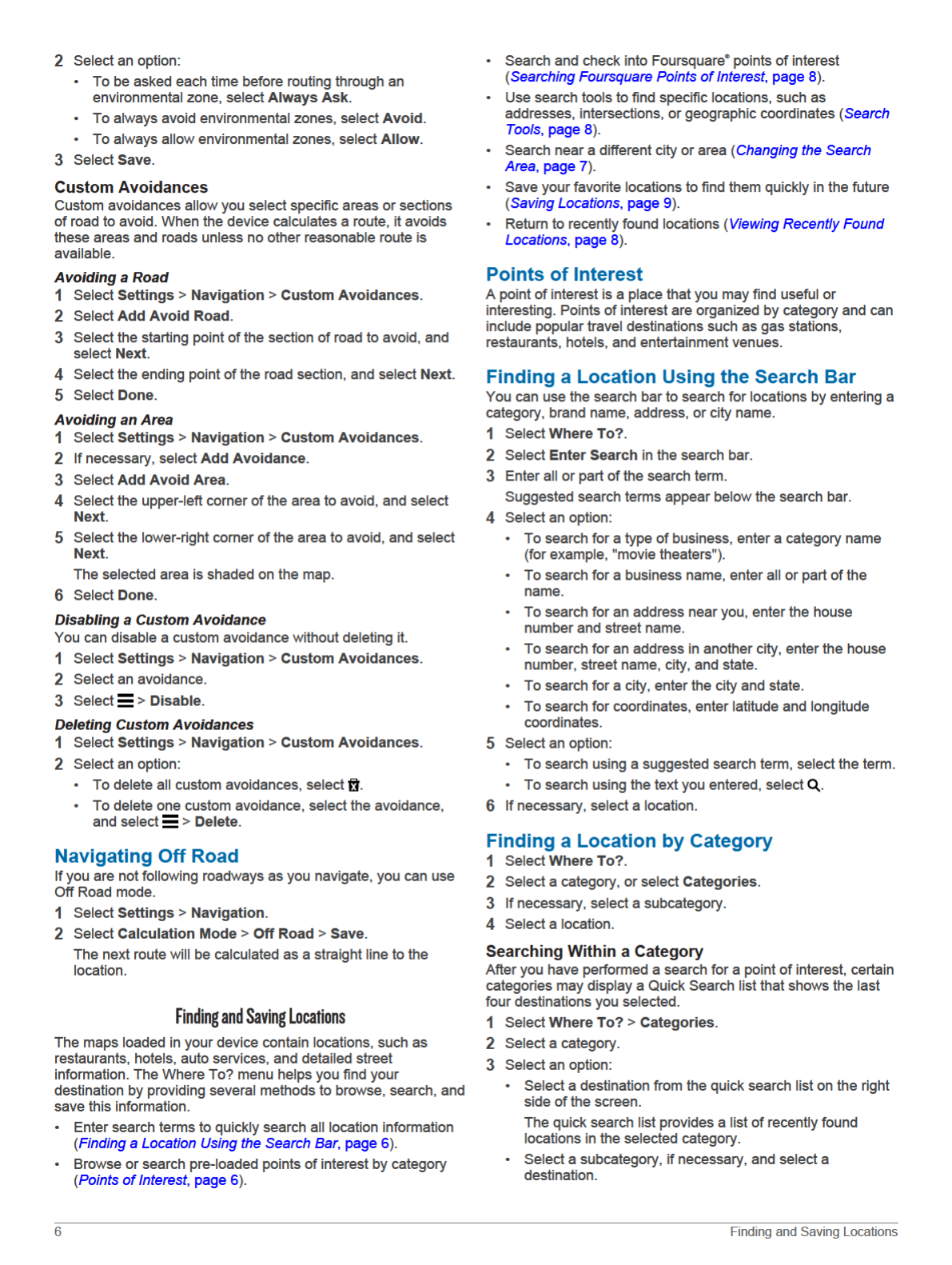
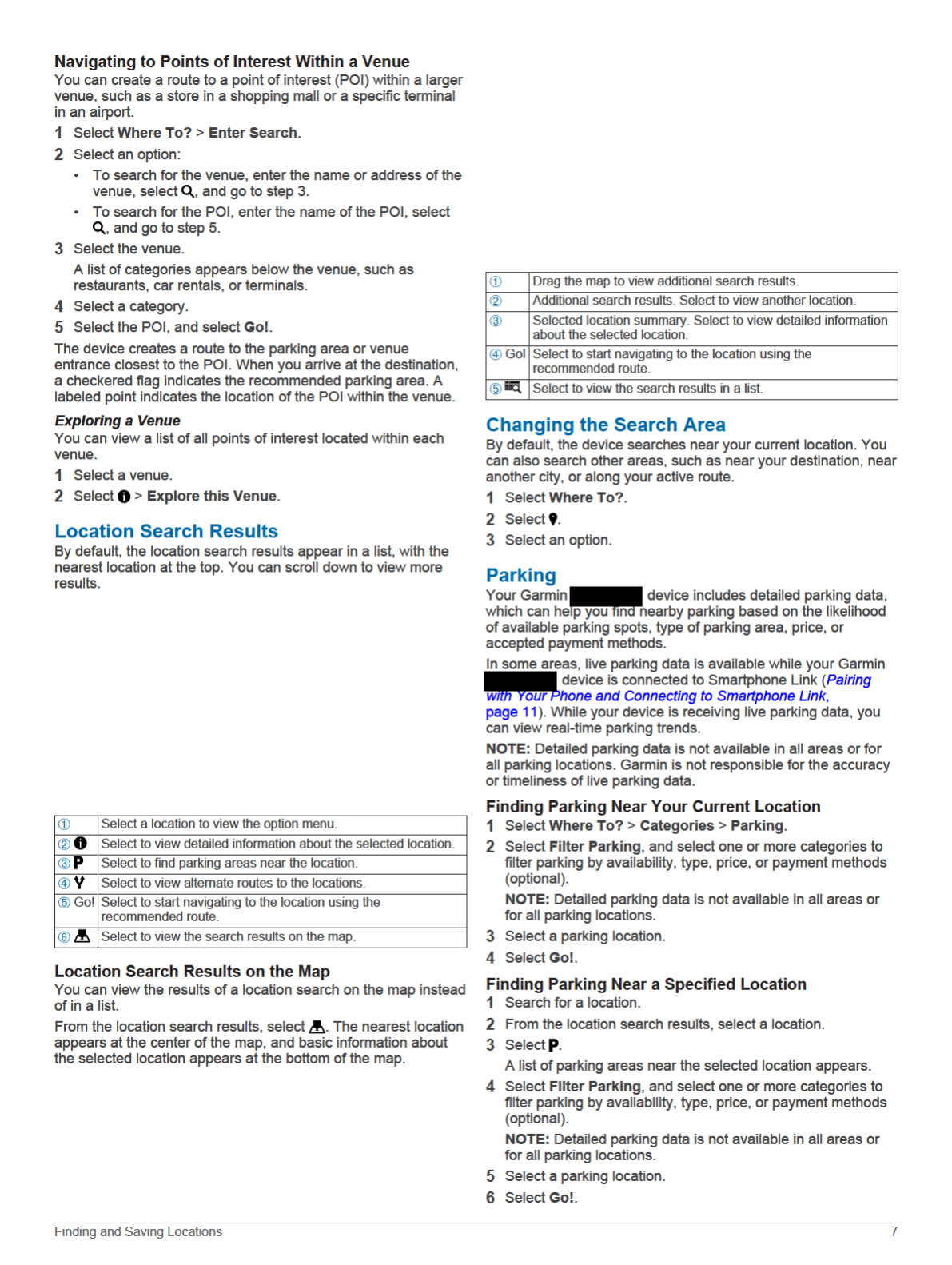
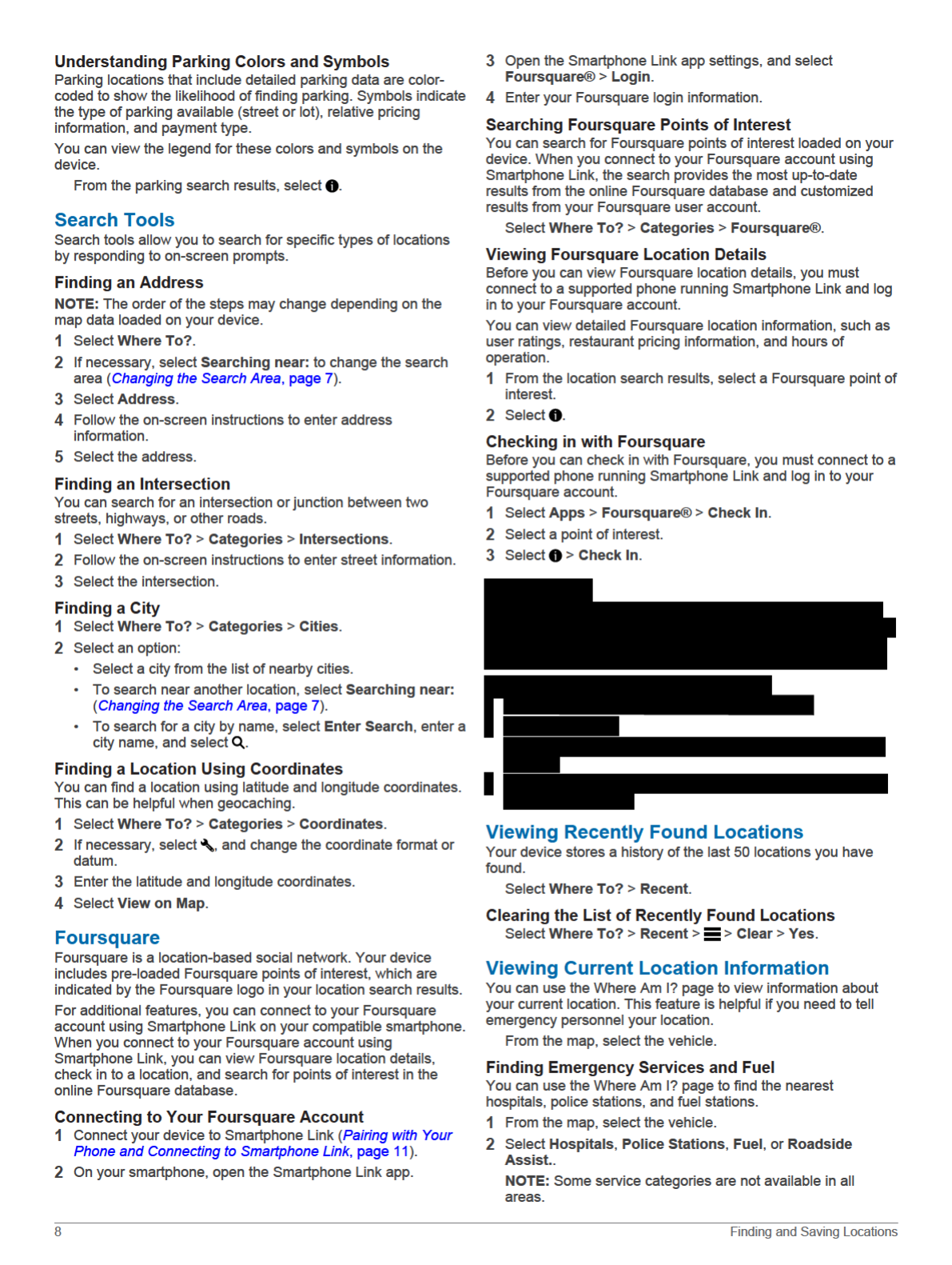

A list of locations for the selected service appears, with the
nearest locations at the top.
3Select a location.
4Select an option:
• To navigate to the location, select Go!.
• To view the phone number and other location details,
select .
Getting Directions to Your Current Location
If you need to tell another person how to get to your current
location, your device can give you a list of directions.
1From the map, select the vehicle.
2Select > Directions to Me.
3Select a starting location.
4Select Select.
Adding a Shortcut
You can add shortcuts to the Where To? menu. A shortcut can
point to a location, a category, or a search tool.
The Where To? menu can contain up to 36 shortcut icons.
1Select Where To? > Add Shortcut.
2Select an item.
Removing a Shortcut
1Select Where To? > > Remove Shortcut(s).
2Select a shortcut to remove.
3Select the shortcut again to confirm.
4Select Save.
Saving Locations
Saving a Location
1Search for a location (Finding a Location by Category,
page 6).
2From the search results, select a location.
3Select .
4Select > Save.
5If necessary, enter a name, and select Done.
Saving Your Current Location
1From the map, select the vehicle icon.
2Select Save.
3Enter a name, and select Done.
4Select OK.
Editing a Saved Location
1Select Where To? > Saved.
2If necessary, select a category.
3Select a location.
4Select .
5Select > Edit.
6Select an option:
• Select Name.
• Select Phone Number.
• Select Categories to assign categories to the saved
location.
• Select Change Map Symbol to change the symbol used
to mark the saved location on a map.
7Edit the information.
8Select Done.
Assigning Categories to a Saved Location
You can add custom categories to organize your saved
locations.
NOTE: Categories appear in the saved locations menu after you
have saved at least 12 locations.
1Select Where To? > Saved.
2Select a location.
3Select .
4Select > Edit > Categories.
5Enter one or more category names, separated by commas.
6If necessary, select a suggested category.
7Select Done.
Deleting a Saved Location
NOTE: Deleted locations cannot be recovered.
1Select Where To? > Saved.
2Select > Delete Saved Places.
3Select the box next to the saved locations to delete, and
select Delete.
Using the Map
You can use the map to navigate a route (Your Route on the
Map, page 3) or to view a map of your surroundings when no
route is active.
1Select View Map.
2Touch anywhere on the map.
3Select an option:
• Drag the map to pan left, right, up, or down.
• To zoom in or out, select or .
• To switch between North Up and 3-D views, select .
• To filter the displayed points of interest by category, select
.
• To start a route, select a location on the map, and select
Go! (Starting a Route by Using the Map, page 3).
Map Tools
Map tools provide quick access to information and device
functions while you view the map. When you activate a map
tool, it appears in a panel at the edge of the map.
Stop: Stops navigation of the active route.
Change Route: Allows you to take a detour or skip locations in
your route.
Up Ahead: Displays upcoming locations along the route or the
road on which you are traveling (Up Ahead, page 10).
Turns: Displays a list of upcoming turns in your route (Viewing
Turns and Directions, page 3).
Trip Data: Displays customizable trip data, such as speed or
mileage (Viewing Trip Data from the Map, page 10).
Volume: Adjusts the master audio volume.
Brightness: Adjusts the screen brightness.
Phone: Displays a list of recent phone calls from your
connected phone, and displays in-call options while a phone
call is active (Using In-Call Options, page 13).
LiveTrack: Allows you to start and stop LiveTrack sharing
(LiveTrack, page 16).
Traffic: Displays traffic conditions along your route or in your
area (Viewing Upcoming Traffic, page 10).
Weather: Displays weather conditions for your area.
photoLive: Displays live traffic cameras from your photoLive
subscription (photoLive Traffic Cameras, page 17).
Using the Map 9
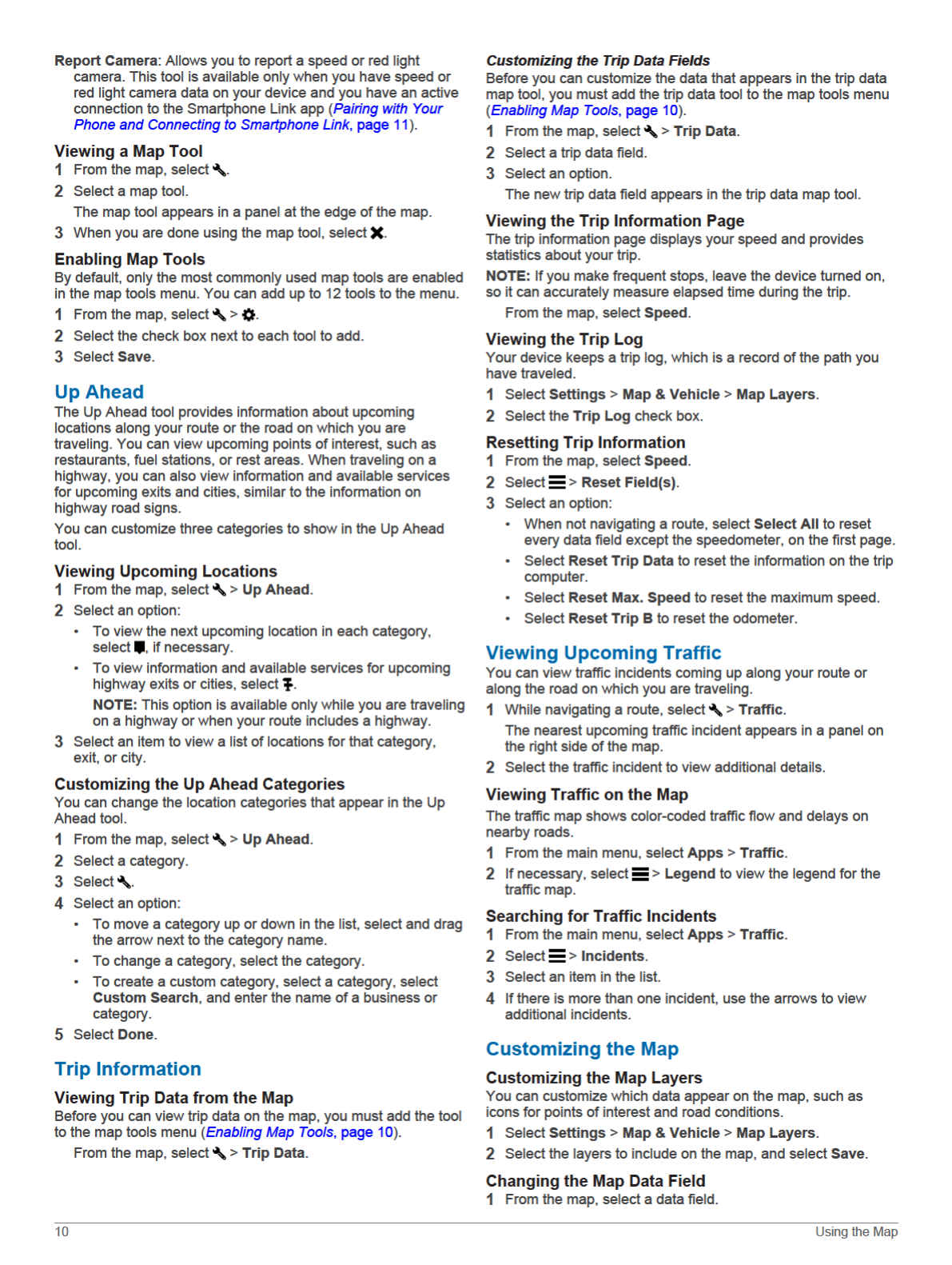
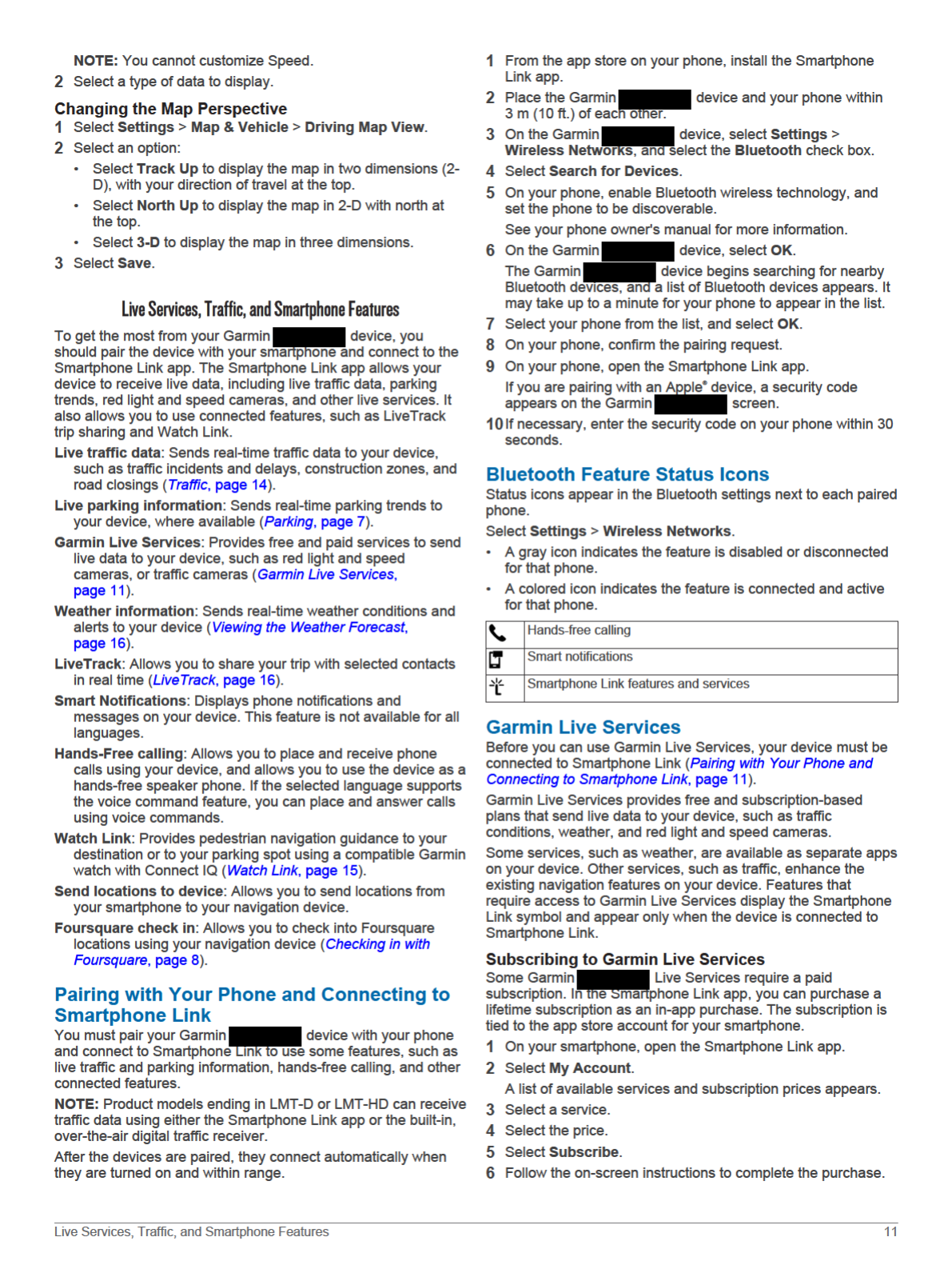
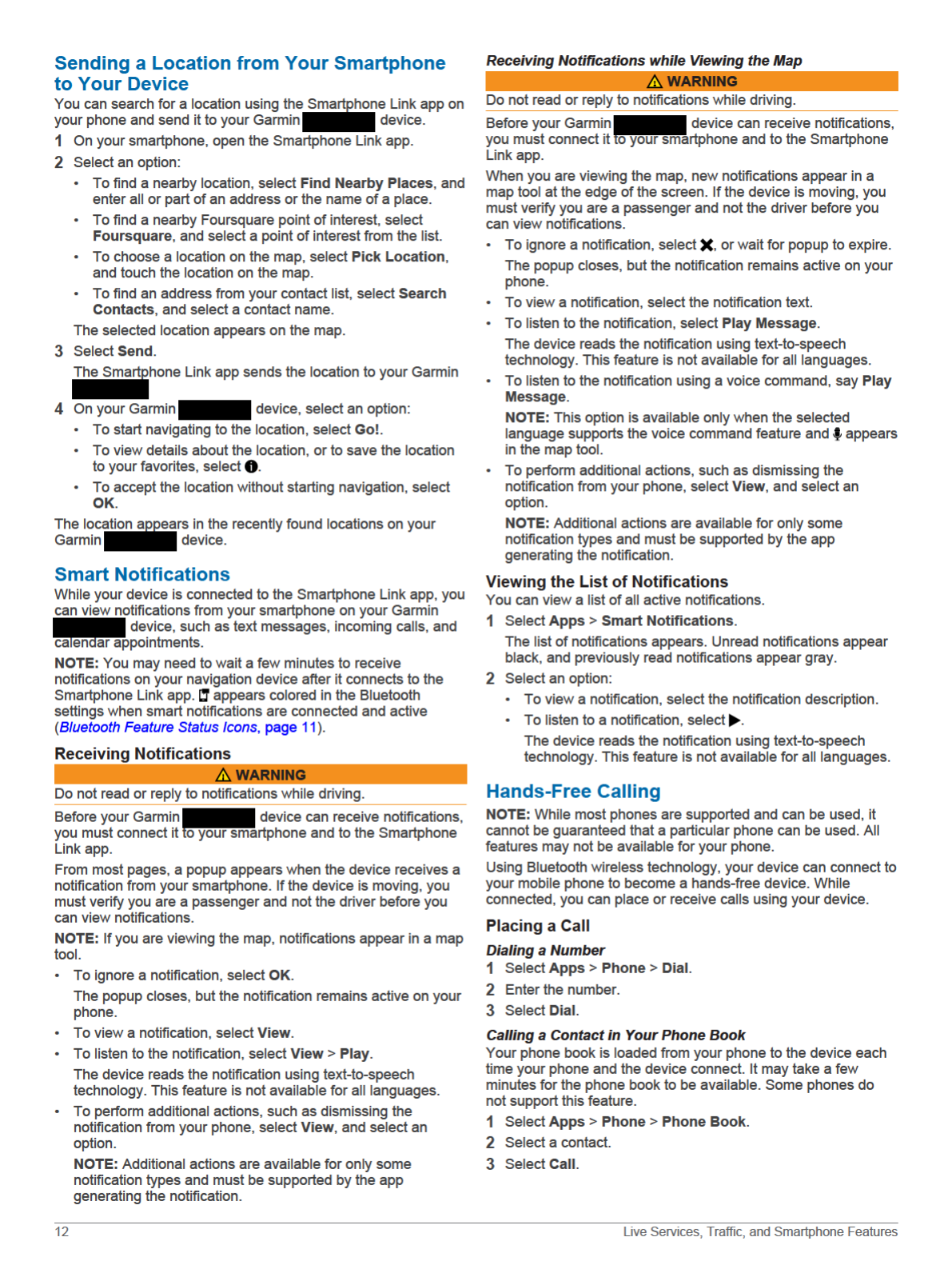
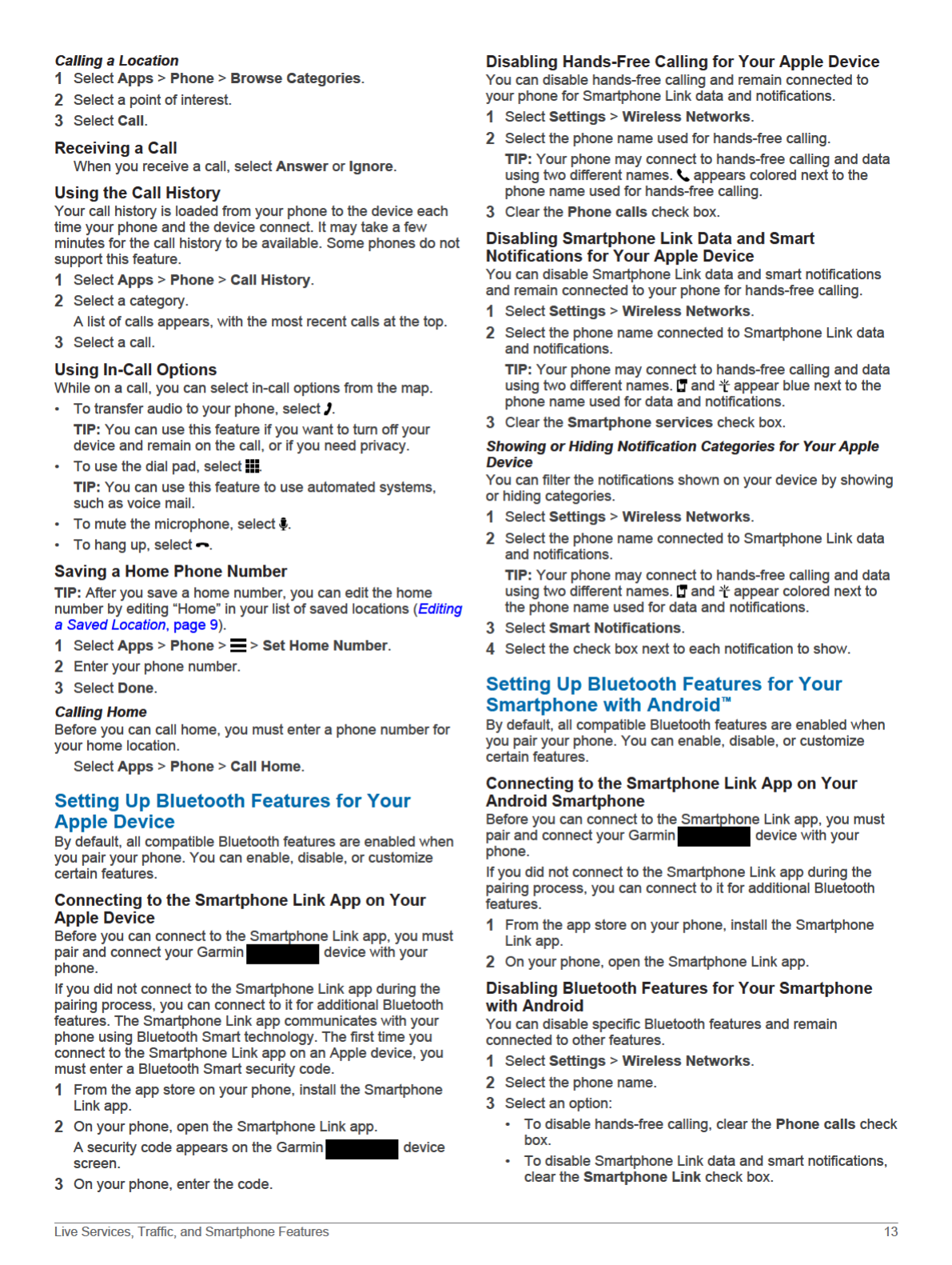

• To disable specific app notifications, use the settings in
the Smartphone Link app.
Showing or Hiding Notifications for Your Smartphone with
Android
You can use the Smartphone Link app to select which types of
notifications appear on your Garmin device.
1On your phone, open the Smartphone Link app.
2Select .
3Verify the Smart Notifications check box is selected.
4From the Notifications section, select Settings.
A list of notification categories and apps appears.
5Select an option:
• To enable or disable a notification, select the toggle switch
next to the category or app name.
• To add an app to the list, select .
Disconnecting a Bluetooth Device
You can temporarily disconnect a Bluetooth device without
deleting it from the paired devices list. The Bluetooth device can
connect to your Garmin device automatically in the
future.
1Select Settings > Wireless Networks.
2Select the device to disconnect.
3Clear the check box next to the name of your paired device.
Deleting a Paired Phone
You can delete a paired phone to prevent it from automatically
connecting to your device in the future.
1Select Settings > Wireless Networks.
2Select the phone, and select Unpair device.
Traffic
NOTICE
Garmin is not responsible for the accuracy or timeliness of the
traffic information.
Your device can provide information about traffic on the road
ahead or on your route. You can set your device to avoid traffic
when calculating routes, and to find a new route to your
destination if a large traffic delay occurs on your active route
(Traffic Settings, page 19). The traffic map allows you to
browse the map for traffic delays in your area.
To provide traffic information, your device must be receiving
traffic data.
• Your device receives free traffic data through the
Smartphone Link app (Receiving Traffic Data Using
Smartphone Link, page 14).
• All product models can receive traffic data using an over-the-
air traffic receiver cable accessory (Receiving Traffic Data
Using a Traffic Receiver, page 14). Go to your product
page at garmin.com to find and purchase a compatible traffic
receiver cable accessory.
• Product models ending in LMT-D or LMTHD can receive
traffic data using the built-in digital traffic receiver and the
included vehicle power cable (Receiving Traffic Data Using a
Traffic Receiver, page 14).
Traffic data is not available in all areas. For information about
traffic coverage areas, go to www.garmin.com/traffic.
Receiving Traffic Data Using Smartphone
Link
Your device can receive free traffic data through the
Smartphone Link app.
1Connect your device to Smartphone Link (Pairing with Your
Phone and Connecting to Smartphone Link, page 11).
2On your Garmin device, select Settings >
Traffic, and verify the Traffic check box is selected.
Receiving Traffic Data Using a Traffic
Receiver
NOTICE
Heated (metallized) windshields could degrade the performance
of the traffic receiver.
A traffic receiver receives traffic data from an over-the-air
broadcast signal, where available. An over-the-air traffic receiver
cable is available as an accessory for all product models. Go to
your product page at garmin.com to find and purchase a
compatible traffic receiver cable accessory. Traffic data is not
available in all areas.
Connect the device to vehicle power using the traffic receiver
cable (Mounting and Powering the Garmin
Device in Your Vehicle, page 1).
NOTE: If your product model ends with LMT-D or LMTHD,
you should use the power cable included with your device.
The power cable has an integrated antenna for the built-in
digital traffic receiver. Where available, the digital traffic
receiver receives traffic data from FM radio stations using HD
Radio™ technology.
When you are within a traffic coverage area, your device can
display traffic information and help you avoid traffic delays.
Traffic Receiver Subscriptions
A regional traffic data subscription is included with most traffic
receivers. You can add subscriptions for additional regions to
your traffic receiver. For more information, go to garmin.com
/traffic.
Viewing Traffic Subscriptions
Select Settings > Traffic > Subscriptions.
Adding a Subscription
You can purchase traffic subscriptions for other regions or
countries.
1From the main menu, select Traffic.
2Select Subscriptions > .
3Write down the FM traffic receiver unit ID.
4Go to www.garmin.com/fmtraffic to purchase a subscription
and get a 25-character code.
The traffic subscription code cannot be reused. You must
obtain a new code each time you renew your service. If you
own multiple FM traffic receivers, you must obtain a new
code for each receiver.
5Select Next on the device.
6Enter the code.
7Select Done.
Enabling Traffic
You can enable or disable traffic data.
1Select Settings > Traffic.
2Select the Traffic check box.
Viewing Traffic on the Map
The traffic map shows color-coded traffic flow and delays on
nearby roads.
1From the main menu, select Apps > Traffic.
2If necessary, select > Legend to view the legend for the
traffic map.
14 Traffic
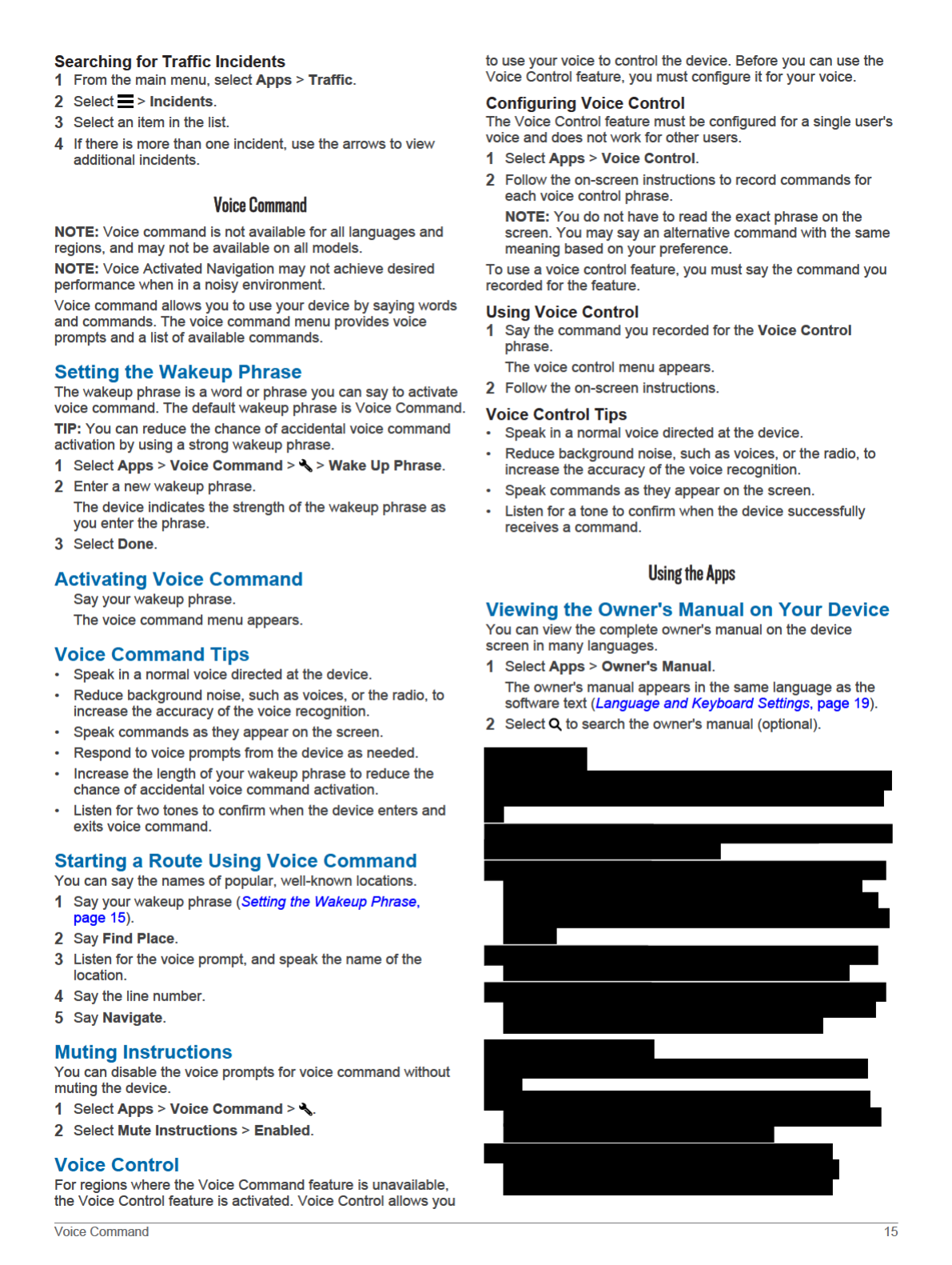
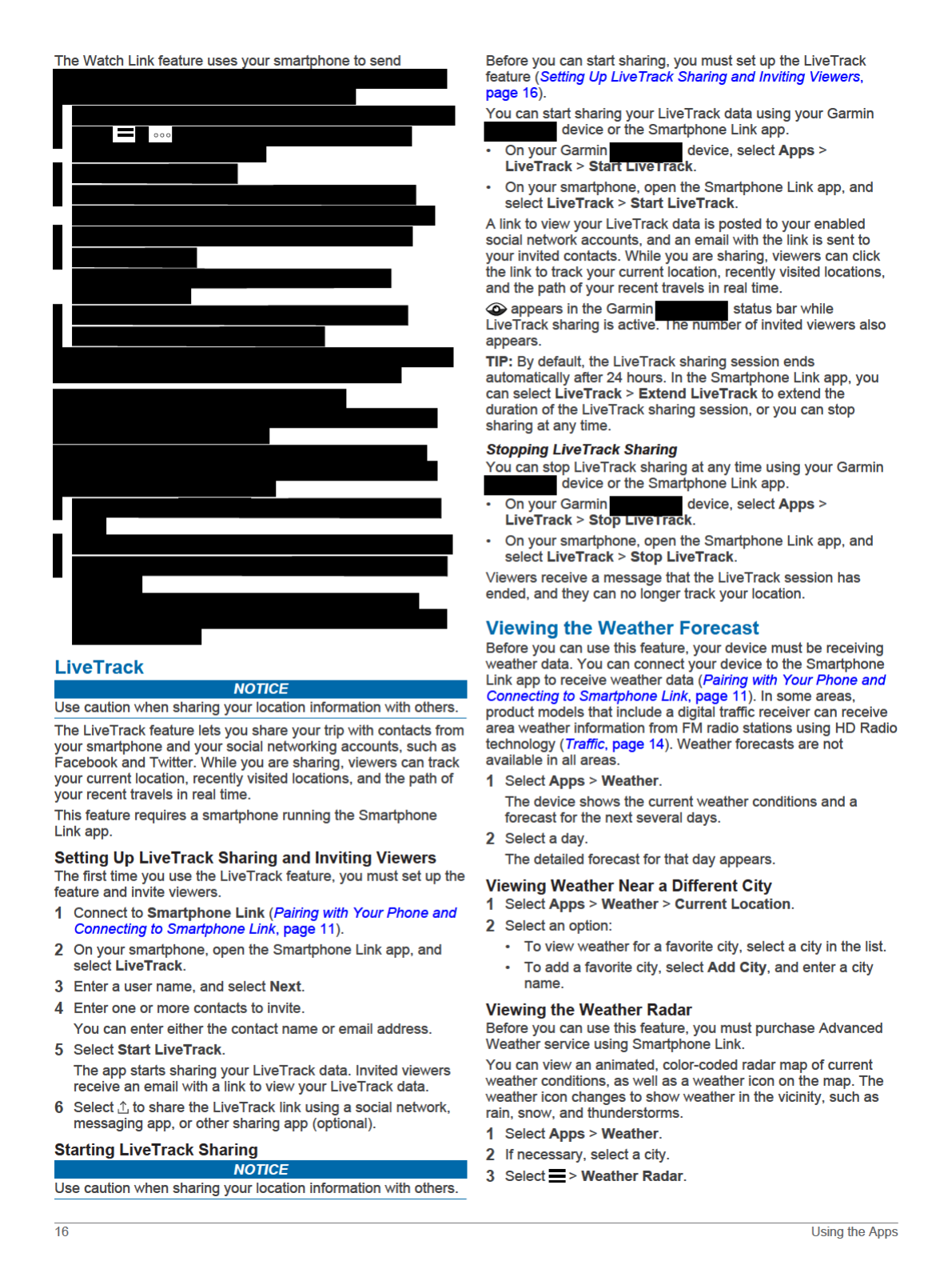
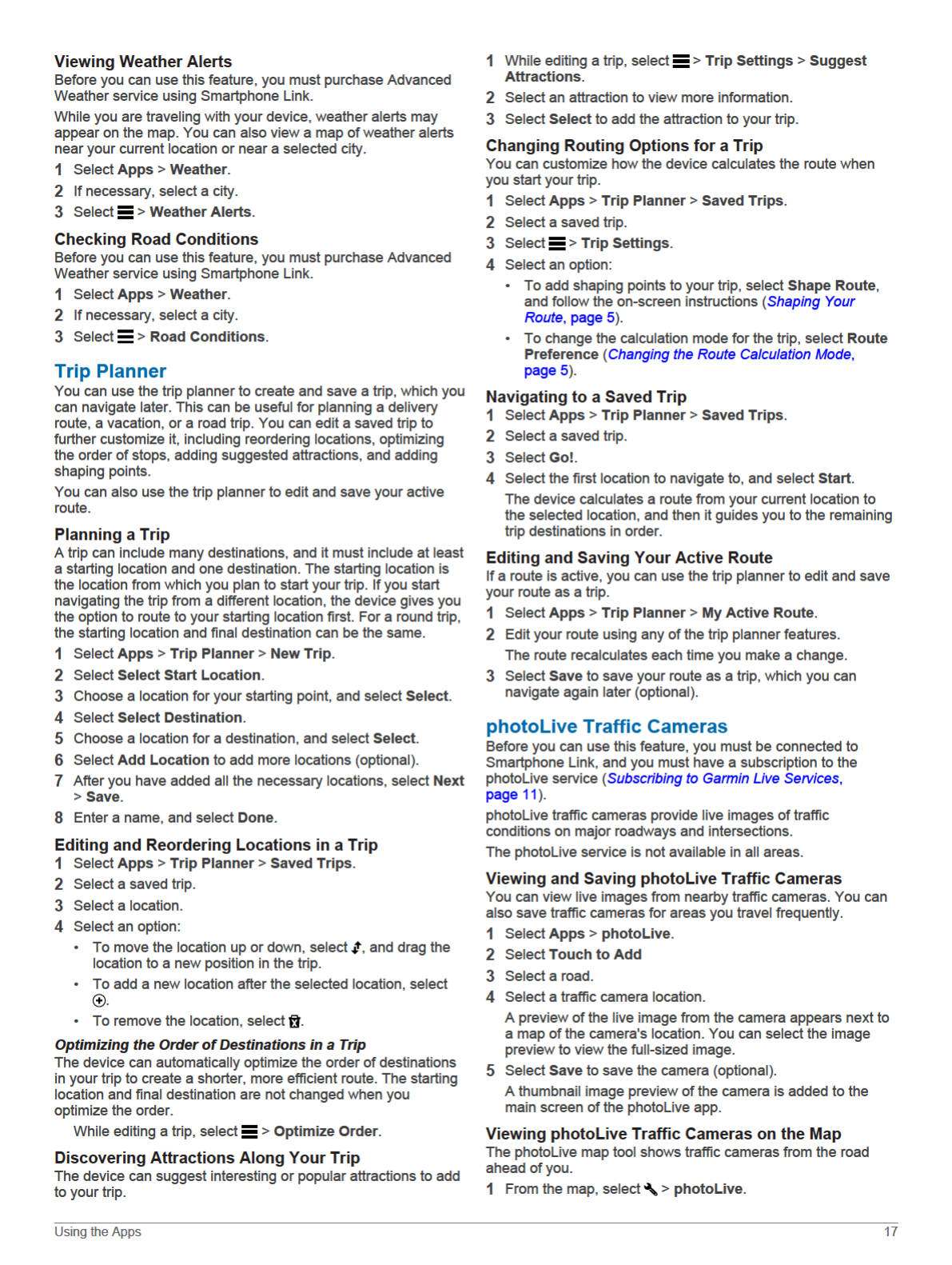
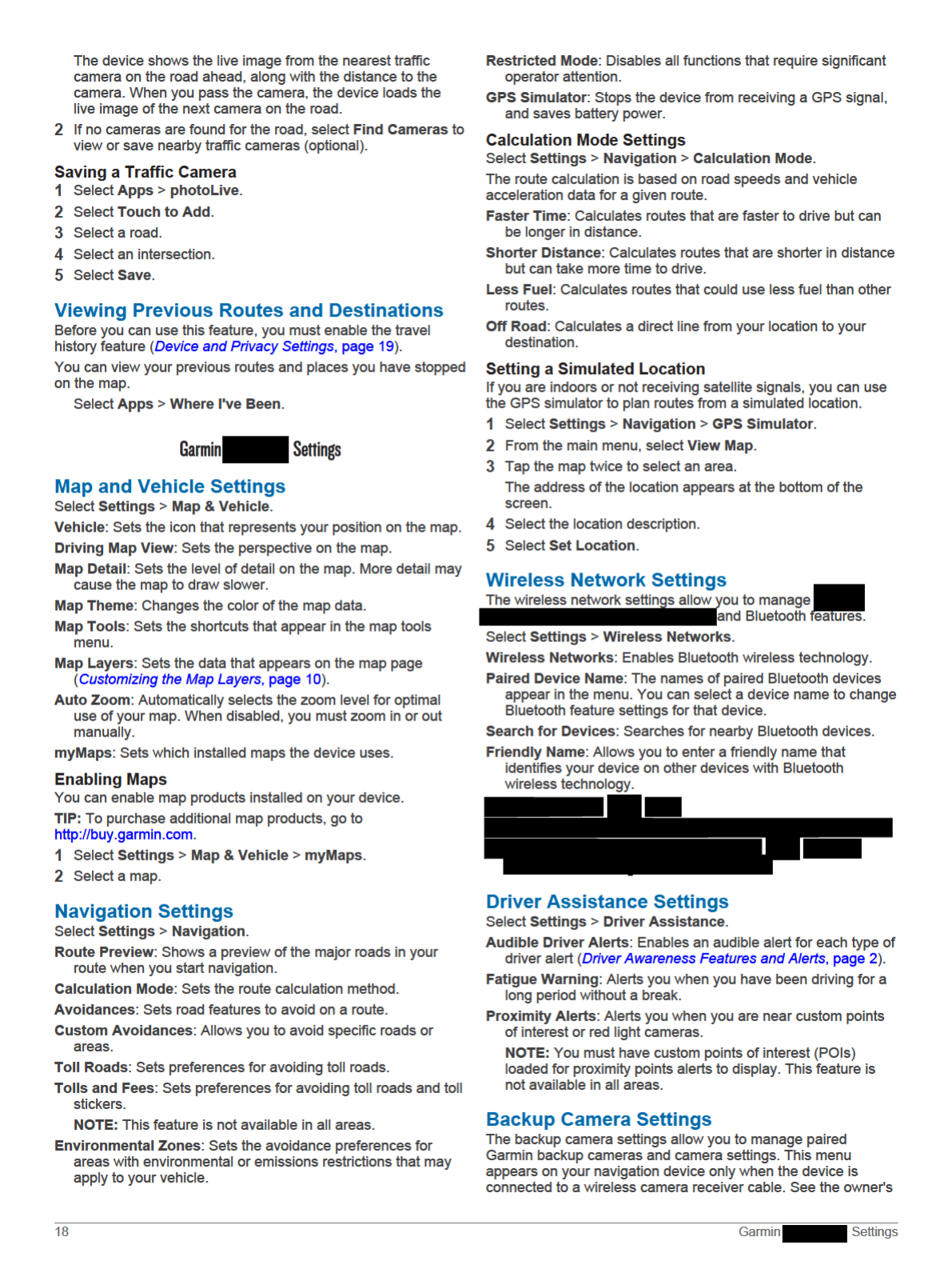

manual for your backup camera for detailed information about
pairing cameras and camera settings. Go to garmin.com
/backupcamera to purchase a Garmin backup camera.
Select Settings > Backup Camera, and select a paired camera.
Unpair: Removes the paired camera. You must pair the camera
again before you can view it using this device and cable.
Rename: Allows you to rename the paired camera.
Guidance Lines: Shows or hides guidance lines and allows you
to adjust the position of the guidance lines.
babyCam Settings
The babyCam settings allow you to manage paired Garmin
babyCam™ cameras and camera settings. This menu appears
on your navigation device only when the device is connected to
a wireless camera receiver cable. See the owner's manual for
your camera for detailed information about pairing cameras and
camera settings. Go to garmin.com/babycam to purchase a
Garmin babyCam camera.
Select Settings > babyCam, and select a paired camera.
Power Settings: Allows you to set the amount of time the video
appears on the screen.
Flip Video: Allows you to flip or mirror the video.
Alignment: Displays the babyCam video to help you align the
camera.
Check Seat Reminder: Enables a reminder to check for rear
seat passengers before exiting the vehicle.
Unpair: Removes the paired camera.
Rename: Allows you to rename the paired camera.
Display Settings
Select Settings > Display.
Orientation: Allows you to set the display to portrait (vertical) or
landscape (horizontal).
Color Mode: Allows you to select day or night color mode. If you
select the Auto option, the device automatically switches to
day or night colors based on the time of day.
Brightness: Allows you to adjust the display brightness.
Display Timeout: Allows you to set the amount of idle time
before your device enters sleep mode while using battery
power.
Screenshot: Allows you to take a picture of the device screen.
Screenshots are saved in the Screenshot folder of the device
storage.
Traffic Settings
From the main menu, select Settings > Traffic.
Traffic: Enables traffic.
Current Provider: Sets the traffic provider to use for traffic data.
The Auto option selects the best available traffic data
automatically.
Subscriptions: Lists the current traffic subscriptions.
Optimize Route: Enables the device to use optimized alternate
routes automatically or upon request (Avoiding Traffic Delays
on Your Route, page 5).
Traffic Alerts: Sets the traffic delay severity for which the
device displays a traffic alert.
Traffic Voice Prompts: Enables voice prompts for traffic
events.
Units and Time Settings
To open the Units and Time settings page, from the main menu,
select Settings > Units & Time.
Current Time: Sets the device time.
Time Format: Allows you to select a 12-hour, 24-hour, or UTC
display time.
Units: Sets the unit of measure used for distances.
Position Format: Sets the coordinate format and datum used
for geographical coordinates.
Setting the Time
1From the main menu, select the time.
2Select an option:
• To set the time automatically using GPS information,
select Automatic.
• To set the time manually, drag the numbers up or down.
Language and Keyboard Settings
To open the Language and Keyboard settings, from the main
menu, select Settings > Language & Keyboard.
Voice Language: Sets the language for voice prompts.
Text Language: Sets all on-screen text to the selected
language.
NOTE: Changing the text language does not change the
language of user-entered data or map data, such as street
names.
Keyboard Language: Enables keyboard languages.
Proximity Alerts Settings
NOTE: You must have custom points of interest (POIs) loaded
for proximity points alerts to display.
NOTE: This feature is not available in all areas.
Select Settings > Proximity Alerts.
Audio: Sets the style of alert that plays when you approach
proximity points.
Alerts: Sets the type of proximity points for which alerts are
played.
Device and Privacy Settings
Select Settings > Device.
About: Displays the software version number, the unit ID
number, and information on several other software features.
Regulatory: Displays regulatory markings and information.
EULAs: Displays the end-user license agreements.
NOTE: You need this information when you update the
system software or purchase additional map data.
Device Data Reporting: Shares anonymous data to improve
the device.
Position Reporting: Shares your position information with
Garmin to improve content.
Travel History: Allows the device to record information for the
myTrends, Where I’ve Been, and Trip Log features.
Clear Travel History: Clears your travel history for the
myTrends, Where I’ve Been, and Trip Log features.
Restoring Settings
You can restore a category of settings or all settings to the
factory default values.
1Select Settings.
2If necessary, select a settings category.
3Select > Restore.
Garmin Settings 19
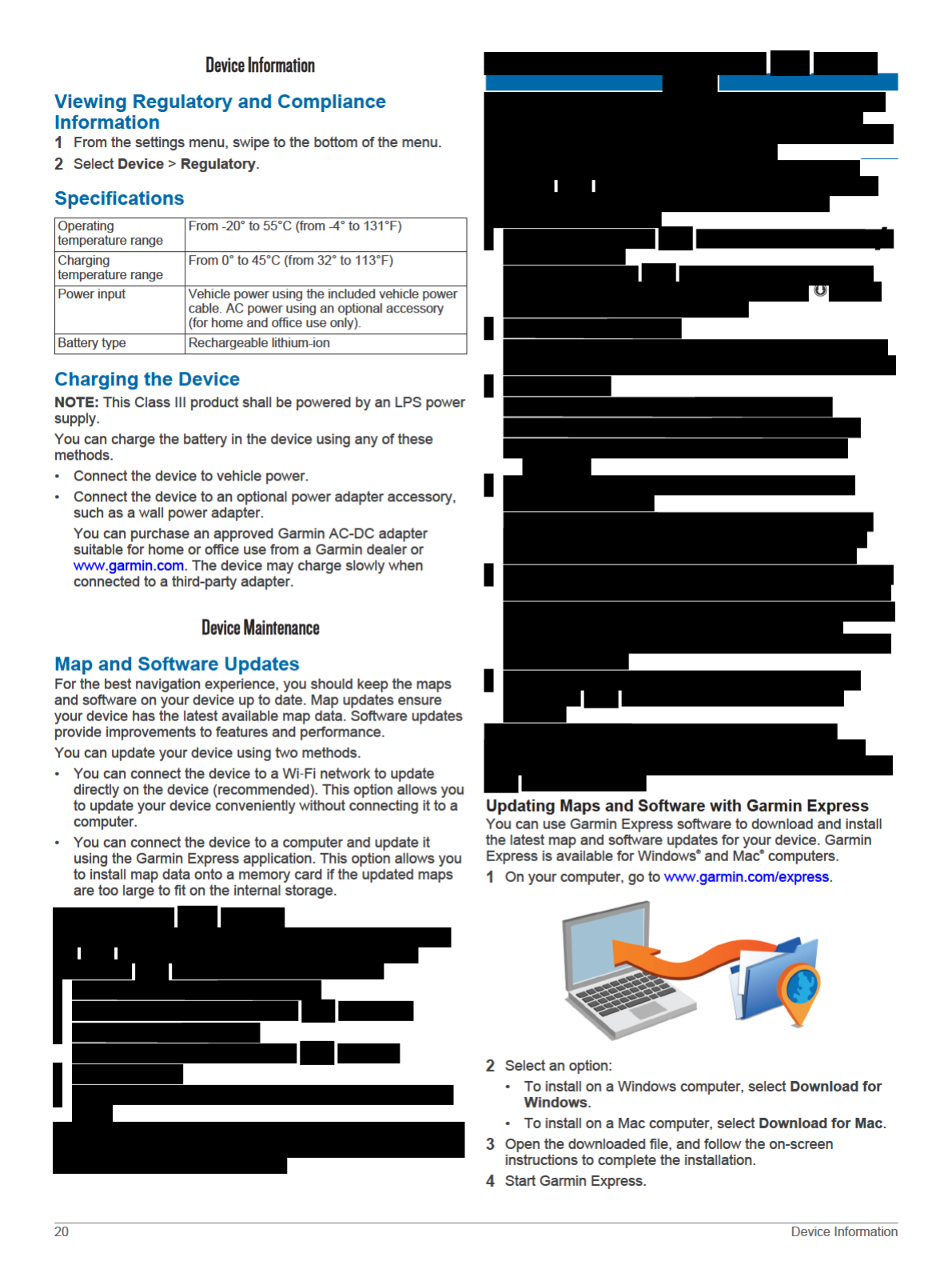
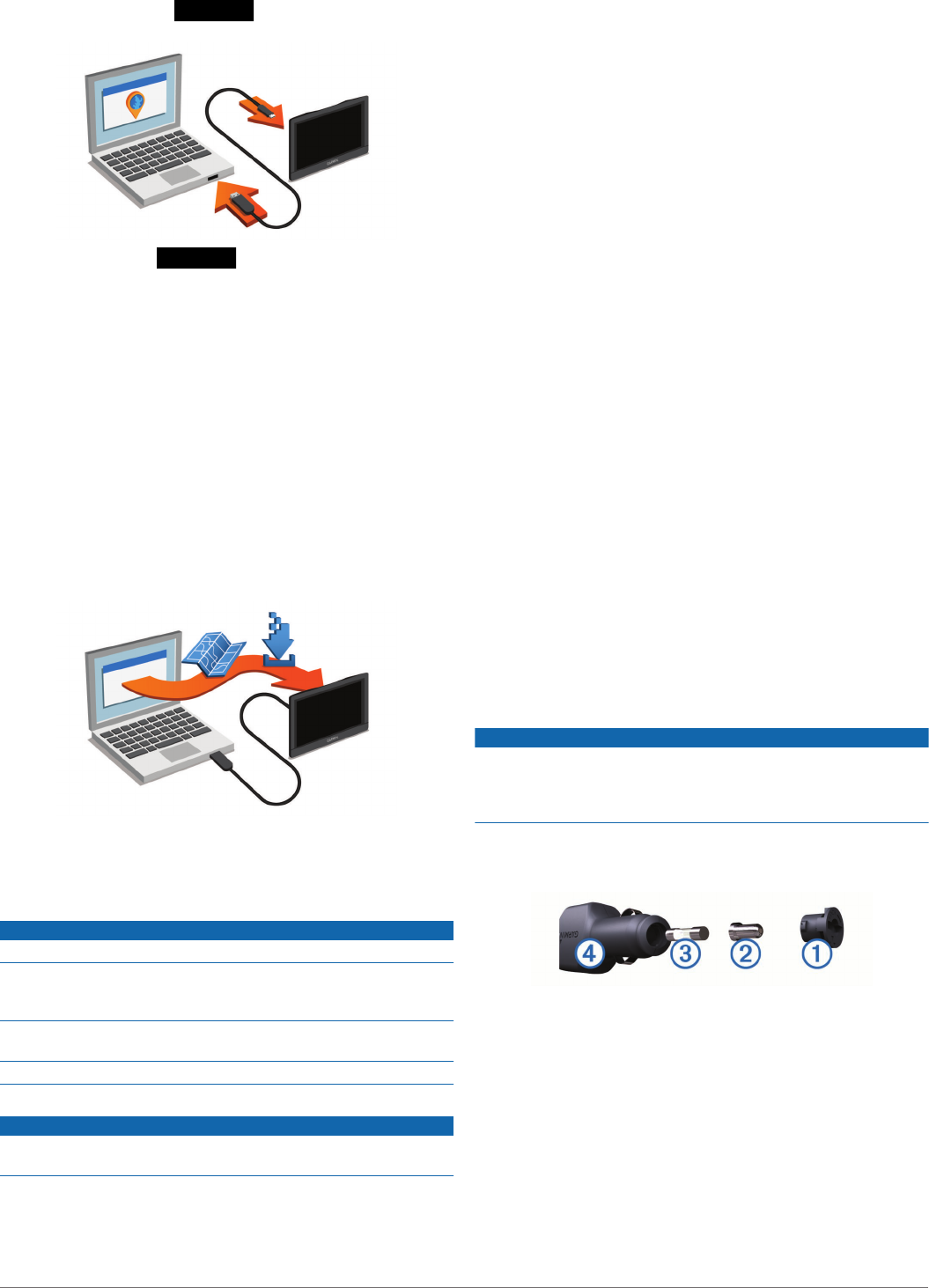
5Connect your Garmin device to your computer
using a USB cable.
6When your Garmin device prompts you to enter
file transfer mode, select Yes.
7On your computer, click Add a Device.
The Garmin Express software detects your device.
8Click Add Device.
9Follow the on-screen instructions to register your device and
add it to the Garmin Express software.
When setup is complete, the Garmin Express software
searches for map and software updates for your device.
10Select an option:
• To install all available updates, click Install All.
• To install a single update, click View Details and select an
update.
NOTE: If a map update is too large for the internal storage of
the device, the software may prompt you to install a microSD®
card in your device to add storage space (Installing a
Memory Card for Maps and Data, page 22).
The Garmin Express software downloads and installs the
updates onto your device. Map updates are very large, and this
process may take a long time on slower Internet connections.
Device Care
NOTICE
Avoid dropping your device.
Do not store the device where prolonged exposure to extreme
temperatures can occur, because it can cause permanent
damage.
Never use a hard or sharp object to operate the touchscreen, or
damage may result.
Do not expose the device to water.
Cleaning the Outer Casing
NOTICE
Avoid chemical cleaners and solvents that can damage plastic
components.
1Clean the outer casing of the device (not the touchscreen)
using a cloth dampened with a mild detergent solution.
2Wipe the device dry.
Cleaning the Touchscreen
1Use a soft, clean, lint-free cloth.
2If necessary, lightly dampen the cloth with water.
3If using a dampened cloth, turn off the device and disconnect
the device from power.
4Gently wipe the screen with the cloth.
Avoiding Theft
• Remove the device and mount from sight when not in use.
• Remove the residue left on the windshield by the suction cup.
• Do not keep your unit in the glove compartment.
• Register your device using the Garmin Express software
(garmin.com/express).
Resetting the Device
You can reset your device if it stops functioning.
Hold the power key for 12 seconds.
Removing the Device, Mount, and Suction
Cup
Removing the Device from the Mount
1Press the release tab or button on the mount.
2Tilt the bottom of the device upward, and lift the device from
the mount.
Removing the Mount from the Suction Cup
1Turn the device mount to the right or left.
2Apply pressure until the socket on the mount releases the
ball on the suction cup.
Removing the Suction Cup from the Windshield
1Flip the lever on the suction cup toward you.
2Pull the tab on the suction cup toward you.
Changing the Fuse in the Vehicle Power
Cable
NOTICE
When replacing the fuse, do not lose any of the small pieces
and make sure they are put back in the proper position. The
vehicle power cable does not work unless it is assembled
correctly.
If your device does not charge in your vehicle, you may need to
replace the fuse located at the tip of the vehicle adapter.
1Rotate the end piece À counter clockwise to unlock it.
TIP: You may need to use a coin to remove the end piece.
2Remove the end piece, the silver tip Á, and the fuse Â.
3Insert a new fast-blow fuse that has the same current, such
as 1 A or 2 A.
4Place the silver tip in the end piece.
5Push in the end piece and rotate it clockwise to lock it back
into the vehicle power cable Ã.
Device Maintenance 21

Troubleshooting
The suction cup will not stay on my
windshield
1Clean the suction cup and windshield with rubbing alcohol.
2Dry with a clean, dry cloth.
3Mount the suction cup (Mounting and Powering the Garmin
Device in Your Vehicle, page 1).
My device is not acquiring satellite signals
• Verify the GPS simulator is turned off (Navigation Settings,
page 18).
• Take your device out of parking garages and away from tall
buildings and trees.
• Remain stationary for several minutes.
The device does not charge in my vehicle
• Check the fuse in the vehicle power cable (Changing the
Fuse in the Vehicle Power Cable, page 21).
• Verify the vehicle is turned on and is supplying power to the
power outlet.
• Verify the interior temperature of the vehicle is within the
charging temperature range indicated in the specifications.
• Verify the fuse is not broken in the vehicle power outlet.
My battery does not stay charged for very
long
• Decrease the screen brightness (Display Settings, page 19).
• Shorten the display timeout (Display Settings, page 19).
• Decrease the volume (Adjusting the Volume, page 2).
• Turn off the wi-fi radio when it is not in use (Wireless Network
Settings, page 18).
• Put the device in power saving mode when not in use
(Turning the Device On or Off, page 1).
• Keep your device away from extreme temperatures.
• Do not leave your device in direct sunlight.
My device does not connect to my phone or
Smartphone Link
• Select Settings > Wireless Networks.
The Bluetooth option must be enabled.
• Enable Bluetooth wireless technology on your phone and
bring your phone within 10 m (33 ft.) of the device.
• On your smartphone, open the Smartphone Link app, and
select > to restart the Smartphone Link background
services.
• Verify your phone is compatible.
Go to www.garmin.com/bluetooth for more information.
• Complete the pairing process again.
To repeat the pairing process, you must unpair your phone
and device (Deleting a Paired Phone, page 14), and
complete the pairing process (Pairing with Your Phone and
Connecting to Smartphone Link, page 11).
The Smartphone Link app affects the battery
charge level on my smartphone
The Smartphone Link app uses Bluetooth wireless technology to
send data to and receive data from your device. It is normal for
an active Bluetooth connection to consume some battery power.
The app also periodically checks for updates to available
services, which may consume additional battery power.
You can change the battery usage settings in the Smartphone
Link app to reduce the amount of battery power the app uses.
1From the Smartphone Link app on your smartphone, select
.
2Scroll to the Battery Usage section, and select Settings.
3Select one or more options:
• Clear the Bluetooth Auto-Connect check box.
Disabling this option may save a small amount of battery
power, but it prevents the app from connecting to your
Garmin device automatically. While this option
is disabled, you must select from the Smartphone Link
main menu each time you want to connect your device to
Smartphone Link.
• Clear the Live Services Check check box.
On some smartphones, disabling this option may
significantly reduce the battery power used by the app.
While this option is disabled, you must manually refresh
the Smartphone Link main menu to receive updated
information about available live services.
Appendix
Installing a Memory Card for Maps and Data
You can install a memory card to increase the storage space for
maps and other data on your device. You can purchase memory
cards from an electronics supplier, or go to www.garmin.com
/maps to purchase a memory card with pre-loaded Garmin
mapping software. The device supports microSD memory cards
from 4 to 32 GB.
1Locate the map and data memory card slot on your device
(Device Overviews, page 1).
2Insert a memory card into the slot.
3Press it in until it clicks.
Data Management
You can store files on your device. The device has a memory
card slot for additional data storage.
NOTE: The device is not compatible with Windows 95, 98, Me,
Windows NT®, and Mac OS 10.3 and earlier.
About Memory Cards
You can purchase memory cards from an electronics supplier,
or purchase pre-loaded Garmin mapping software
(www.garmin.com). In addition to map and data storage, the
memory card can be used to store files such as maps, images,
geocaches, routes, waypoints, and custom POIs.
Connecting the Device to Your Computer
You can connect the device to your computer using a USB
cable.
1Plug the small end of the USB cable into the port on the
device.
2Plug the larger end of the USB cable into a port on your
computer.
3When your Garmin device prompts you to enter
file transfer mode, select Yes.
A picture of your device connected to a computer appears on
the device screen.
Depending on your computer operating system, the device
appears as either a portable device, a removable drive, or a
removable volume.
Transferring Data From Your Computer
1Connect the device to your computer (Connecting the Device
to Your Computer, page 22).
22 Troubleshooting

Depending on your computer operating system, the device
appears as either a portable device, a removable drive, or a
removable volume.
2On your computer, open the file browser.
3Select a file.
4Select Edit > Copy.
5Browse to a folder on the device.
NOTE: For a removable drive or volume, you should not
place files in the Garmin folder.
6Select Edit > Paste.
Disconnecting the USB Cable
If your device is connected to your computer as a removable
drive or volume, you must safely disconnect your device from
your computer to avoid data loss. If your device is connected to
your Windows computer as a portable device, it is not necessary
to safely disconnect.
1Complete an action:
• For Windows computers, select the Safely Remove
Hardware icon in the system tray, and select your device.
• For Mac computers, drag the volume icon to the trash.
2Disconnect the cable from your computer.
Viewing GPS Signal Status
Hold for three seconds.
Purchasing Additional Maps
1Go to your device product page at garmin.com.
2Click the Maps tab.
3Follow the on-screen instructions.
Purchasing Accessories
Go to garmin.com/accessories.
Appendix 23
